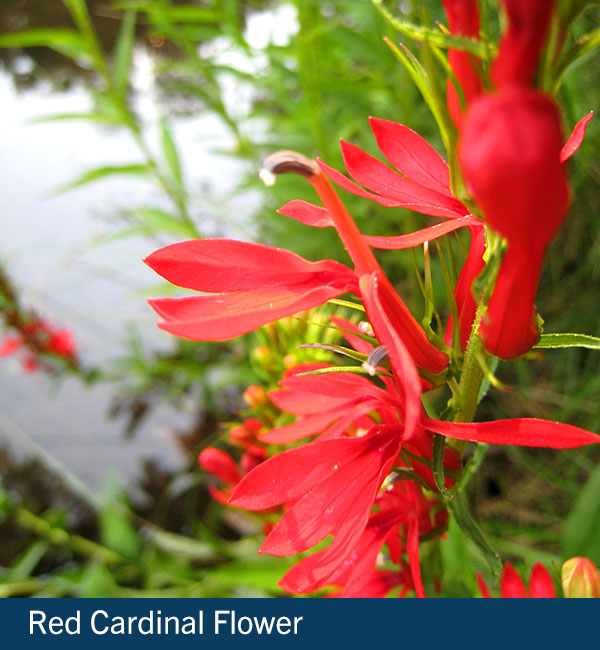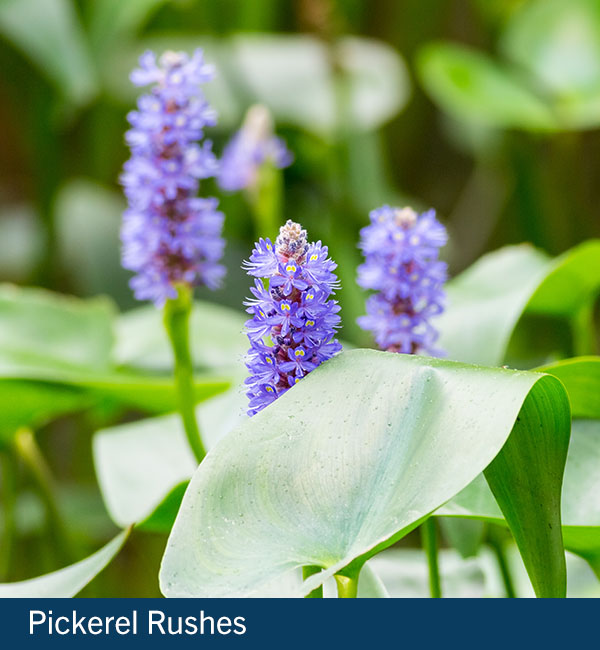In our recent article, we covered the two zones required for a BioSwimPond®: a regeneration zone and a swimming zone. Now, we are ready to go deeper into the regeneration zone.This is a zone that relies on aquatic plants to act as a natural filter to purify water before reentering it into the swimming zone, while also adding great visual interest to the pond.
There are four main types of aquatic plants for natural swimming ponds that work together to filter out contaminants and absorb nutrients from the water, which prevents algae from getting those nutrients and becoming invasive. These aquatic plants also improve the pond’s overall aesthetics by adding color, height, texture and visual interest to your backyard.
Floating Plants
These plants are not attached to the bottom of a body of water and as the name suggests they simply float at or near the surface of the water. Most have roots that dangle in the water and absorb nutrients in that way. They also provide great shade to the pond, which prevents the water from overheating and developing algae growth.
Examples:
- Water Lilies: Easy to grow, but require 6 hours of sunlight to thrive and produce flowers. These plants provide a lot of surface cover, shade and even the perfect place for a frog to relax.
- Water Hyacinth: Flower stalks that will hold as many as 20 gorgeous lavender flowers by the end of spring. They need full sun and hot summer temperatures. NOTE: These are illegal in several states.

Submerged Plants
These plants grow underwater in pots below the water’s surface and require constant exposure to sunlight. While some portions may grow above the water, most of the plant is submerged. These plants absorb nutrients through their leaves, not their roots. They also clean the water by feeding on decaying material in a pond’s leaves. A high level of oxygen is extremely beneficial to keeping algae levels under control.
Examples:
- Red Cardinal Flowers: Easy to care for and easy on the eyes, this gorgeous red flower can grow up to 1.5-3 feet tall. These plants provide a welcomed pop of color in the mid-summer to fall when other plants may be fading.
- Green Foxtail: This light green plant with fine and feathery leaves can add a naturalistic look to your pond. Easy to care for and a great fit for beginners. May be sold in bunches or single strands.

Emergent Plants
These are rooted underwater, but the largest part of the plants are growing above the water. This adaptation allows the leaves to photosynthesize more efficiently, providing more oxygen and nutrients to submerged parts of the plant. Emergent plants often grow along the edges of bodies of water, where the water is shallower. Unlike submergent plants, these plants can stand on their own without support from the water.
Examples:
- Graceful Cattail: Tall, sturdy plants with long, flat leaves and long cylindrical brown flower spikes that can add height and texture to your pond. Easily grow 4-5 feet in areas with a constant source of water.
- Pickerel Rushes: An elegant flowering plant with purple, pink or white flowers that will bloom all summer long and into October. This plant adds height (2-3 feet) and character to the edge of ponds. Pickerel Rushes can also be grown as submerged plants as well.

Marginal Plants
These plants grow in a pond’s borders or margins, where they absorb nutrients such as phosphorus and nitrogen before pesky algae can. Marginal plants prefer to have their roots and crown wet, so they thrive in continuously saturated soil. They are also often home to toads, newts and salamanders.
Examples:
- Creeping Jenny: A low-growing plant with round green and yellow leaves. This plant will eagerly fill in empty spaces by spilling down the side of a container or cascading down the rocks near a waterfall. Adds textural interest and excellent groundcover.
- Blue Iris: A flowering plant with colorful blooms that range from light blue to purple. They grow between 20-30 inches tall and need full sun. Blue Iris can rapidly spread though, so it’s recommended that they are planted in a pond basket or other container.

When designing your BioSwimPond® you will have countless options when it comes to the plants for your regeneration zone. A healthy living pool should have a variety of native aquatic plants from all four categories, but it’s important to consider the plants that will thrive in your area. Many aquatic plants are perennials, so you should seek plants that will be able to tolerate year-round weather conditions in your region. When in doubt, you can always speak to your local native plant supplier who will be happy to offer suggestions on appropriate plants to introduce to your natural pond.
The experts at Nature’s Way Living Pool are also here to help you every step of the way when designing your BioSwimPond®. Schedule your personal consultation with us today!

